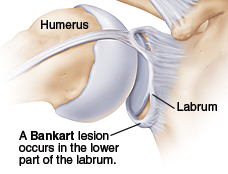Shoulder Dislocations and Instability
Shoulder dislocations are common in athletes and active patients, but also can occur after various injuries. The shoulder is the most commonly dislocated joint in the body. Shoulder dislocations can result in a special type of labral tear called a Bankart tear (or lesion). A Bankart tear is a labral tear located in the three to six o’clock position in right shoulders, and the six to nine o’clock position in left shoulders. Initial treatment of most shoulder dislocations is nonoperative, involving a period of immobilization, and a course of anti-inflammatory medications (advil, alieve, etc) or cortisone injections in conjunction with a course of physical therapy. Shoulder dislocations can lead to recurrent episodes of instability (repeat dislocations). The incidence of recurrent dislocation is based on patients age. Younger patients have a much greater propensity to have repeat dislocations. Patients under twenty years old can have recurrent dislocations in up to 90% of cases. For this reason, certain patients (young athletes, especially those in contact sports) may consider early surgical repair of their dislocation. Recurrence is lower in older patients, but patients over 40 years old have an associated incidence of rotator cuff tears. A rotator cuff tear is an indication to have your shoulder dislocation treated surgically. Dr. Walker will review your options and guide you to the most appropriate treatment for your injury.

Bankart Lesion
You will need the Adobe Reader to view and print these documents. 


